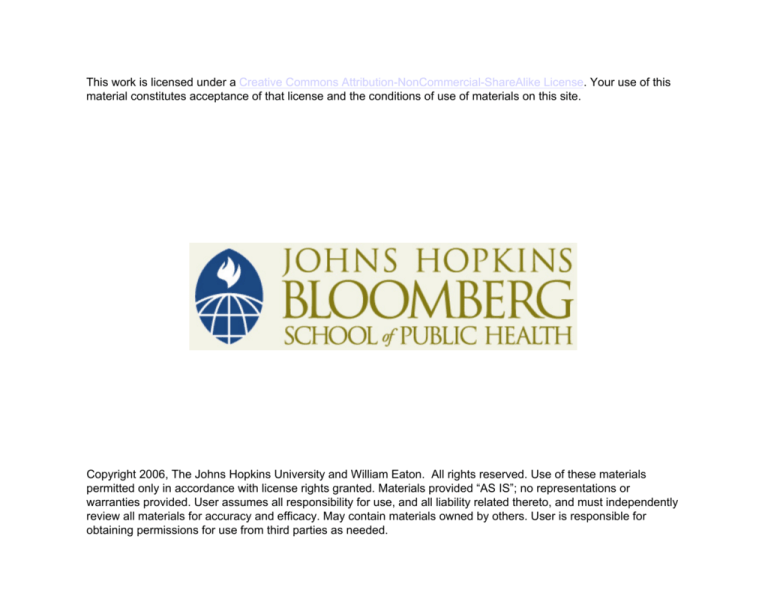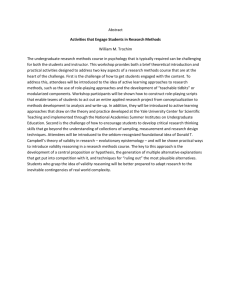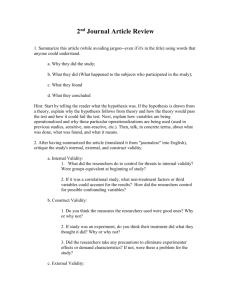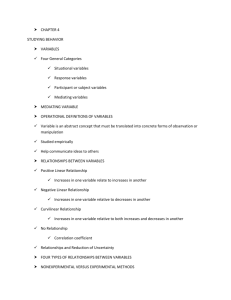
This work is licensed under a Creative Commons Attribution-NonCommercial-ShareAlike License. Your use of this
material constitutes acceptance of that license and the conditions of use of materials on this site.
Copyright 2006, The Johns Hopkins University and William Eaton. All rights reserved. Use of these materials
permitted only in accordance with license rights granted. Materials provided “AS IS”; no representations or
warranties provided. User assumes all responsibility for use, and all liability related thereto, and must independently
review all materials for accuracy and efficacy. May contain materials owned by others. User is responsible for
obtaining permissions for use from third parties as needed.
Statistics in Psychosocial Research
Lecture 5
Validity I
Lecturer: William Eaton
Validity
The degree to which a test, scale, or assessment
measures what it is supposed to measure.
Outline
• Face Validity
• Content Validity
• Construct Validity
• Internal
• External
• Criterion Validity
• Concurrent
• Predictive
• Validity and reliability
• Validity and utility
Classical Test Theory and Reliability:
x = Tx + e
The observed score equals the true score plus random
measurement error
Validity
x = Tx + es + er
The observed score equals the true score plus systematic
error (bias) plus random measurement error
Face Validity
Does the item seem right?
CESD: Depression: “I felt depressed”
MMPI: Schizophrenia: “I believe in God”
•
•
•
•
Increases motivation among respondents
Reduces dissatisfaction among respondents
Enhances credibility of results
Improves public relations
Face Validity: IQ Test
Example
1. What would be the next number in this series?
1 ... 2 ... 3 ... 5 ... 8 ... 13 ... 21 ... 34 ... ??
47
53
55
62
65
I don't know
Face Validity: IQ Test
Example
2. If you rearrange the letters NLIRBE, you would have
the name of a
River
Country
City
Animal
Plant
I don't know
Face Validity: IQ Test
Example
3. Napoleon lost his final battle at
Moscow _ Waterloo _ Leipzig _ Berlin _ Paris
Moscow
Waterloo
Leipzig
Berlin
Paris
I don't know
Content Validity
The extent to which one can generalize from a particular
collection of items to all possible items that would be
representative of a specified domain of items (Nunnaly, 1978)
• A final exam for this course should measure information
about measurement that was presented in this course -- it
should not be validated in terms of its correspondence to
some other course, e.g., biostatistics, epidemiology courses
• Spelling among fourth graders: random sample of all
words in widely used fourth grade readers, in groups of
four: test is to circle one incorrectly spelled word
• “Big Five” Personality Traits: systematic sampling, over
generations of research, of all words in the English
dictionary which describe personality
Major Depressive Episode
(MDE): Diagnostic Criteria
At least five of the following symptoms have been present
during the same two-week depressed period
–
–
–
–
–
–
–
–
–
Depressed mood
Loss of all interest and pleasure
Appetite or weight disturbance
Sleep disturbance
Agitation or slowing
Fatigue or loss of energy
Abnormal self-reproach or inappropriate guilt
Poor concentration or indecisiveness
Thoughts of death or suicide
Content Validity of CESD-R for MDE
• Depressed mood
– I felt sad
– I felt depressed
• Loss of all interest or pleasure
– Nothing made me happy
– I lost interest in my usual activities
• Appetite or weight disturbance
– I lost a lot of weight without trying to
– My appetite was poor
• Sleep disturbance
– I slept much more than usual
– I had a lot of trouble getting to sleep
• ETC. (five more symptom groups)
Construct: A Theory About How
Experiences Are Organized
• Something . . . “scientists put together from their own
imaginations….” Nunnaly
• “A mini-theory to explain the relationships among various
behaviors or attitudes.” Streiner and Norman
• “A latent variable … that causes items to be correlated….
An unobservable . . . that varies among persons”
paraphrased from DeVellis
• “A hypothesis that a variety of items will correlate with
one another and will be similarly affected by such factors
as experimental treatments, psychosocial factors, and
biology” Miech
Constructs
•
•
•
•
•
•
•
Intelligence
Neuroticism
Feminism
Stress
Distress
Job Strain
Social Class
•
•
•
•
•
•
•
Dropsy
Fever
Gulf War Syndrome
Interstitial Cystitis
Rheumatoid Arthritis
Planet
Selenium
Construct Validity
“the extent to which an operational measure truly
reflects the concept being investigated or the
extent to which operational variables used to
observe covariation in and between constructs can
be interpreted in terms of theoretical constructs .”
(Calder et al, 1982, in Netemeier et al, page 71)
“the degree to which a measure satisfies theoretical
predictions about the construct, across a range of
theories, and with a range of modalities of
measurement”
Steps in Construct Validation
(Streiner and Norman from Cronbach and Meehl, 1955)
1.
2.
3.
4.
Spell out a set of theoretical constructs
State how they should be related
Develop measures for the constructs
Conduct studies to see whether the
observed relationships between measures
(step 3) agrees with the stated theories
(step 2)
Two Major Aspects to Evaluate
Construct Validity
1.
Internal construct validity: the degree to which items in the
measure are associated with each other in the theoretically
predicted direction
a.
Discriminant validity: the degree to which a scale is
associated with measures of similar constructs and not
associated with measures of distinct constructs
b. Convergent validity: the degree to which a scale is
associated with measures of similar constructs even when
they are measured with a different modality
2.
External/nomological construct validity: the degree to which a
scale is associated with other constructs in the theoretically
predicted direction
Modalities of Measurement
•
•
•
•
•
•
•
•
Clinical Rating
Examination
Self-report-- Structured Interview
Telephone Interview
Computer-assisted Interview
Paper and pencil
Informant Interview
Biological assay
• Variable analysis– Herbert Blumer
• Monomethod bias
• Post-hoc validation
Failure of Discriminant Validity Estimates of
Correlation between Scales if Keyed for the Same
Time Period
Scale
Langner with CESD
Langner with GWB
Langner with GWB
Langner with SCL-90
HOS with CESD
HOS with GWB
CESD with SCL-90
CESD with SCL-90
GWB with CES-D
GWB with SCL-90
Corr
.852
-.976
-.932
.802
.752
-.856
.800
.930
-.796
-.760
source: Mental Illness in the United States: Epidemiological Estimates, Dohrenwend
and Dohrenwend, eds. 1982.
Known Groups Validation
Consumers’ Need for Uniqueness Scale
Group
Sample
Size
621
Mean
Tattoo artists
39
3.05
Owners of customized low-rider autos
22
2.99
Members of Society for Creative
Anachronism
Art majors
21
2.91
22
3.06
Convenience Group Mail Survey
Netemeyer et al, p. 81, from Tian et al, JCR, 2001
2.60
Level of Depression
Low
High
Construct Validation for Four Measures
of Depression: Stress and Depression
1
2
3
Levels of Stress
4
5
Construct Validation for Four Measures
of Depression: Gender and Depression
Level of Depression
Low
High
Males
Females
1
2
3
Levels of Stress
4
5
Level of Depression
Low
High
Construct Validation for Four Measures of
Depression: Dexamethasone Suppression
and Depression
*
*
Low
** *
*
Medium
High
Dexamethasone Suppression
Criterion Validation
• Requires a well-accepted criterion
– “Gold Standard”
– “Lead Standard”
• Useful only when new test has some outstanding
characteristic in comparison to the accepted one, e.g.,
– Expensive (Structured Diagnostic Interview versus Psychiatrist’s
Examination)
– Invasive (e.g., PSA versus digital examination)
– Dangerous (Mantoux test for TB versus Chest X-ray)
– Time-consuming
• Criterion validity highlights correspondence alone
• Generates quantitative measure of validity
Criterion validity
Association of a test measure with a criterion variable
• Concurrent validity
– correlation of CESD with HAMD
– correlation of “Do you feel hot?” with temperature from
thermometer
– Correlation of donation pledge with acutal contribution
– Correlation of self-report personality traits with peer
reports of same traits
• Predictive Validity
– success in college from SAT’s; grad school from GRE’s
– Psychotic episode during young adulthood from psychosis
proneness measures like magical ideation, recurrent
illusions, social avoidance at beginning of college
– General Health Questionnaire with visit to psychiatrist
CESD items
I felt sad
I felt depressed
Nothing made me happy
I lost interest in my usual
activities
I lost a lot of weight without
trying to
My appetite was poor
I slept much more than usual
I had a lot of trouble getting to
sleep
ETC. (five more symptom groups)
CAGE Screening for Alcoholism
• Cut down on drinking-have tried repeated without
success (Yes/No)
• Annoyed by criticism about drinking habits
(Yes/No)
• Guilty feelings about drinking (Yes/No)
• Eye opener drink needed in the morning (Yes/No)
Sensitivity and Specificity of CAGE
Pooled value
All studies
Primary care
Ambulatory
medical patients
Inpatients
CAGE score
1
2
3
4
1
2
3
4
1
2
3
4
1
2
3
4
Sensitivity
0.87
0.71
0.42
0.20
0.85
0.71
0.45
0.23
0.83
0.60
0.33
0.13
0.98
0.87
0.50
0.23
Specificity
0.68
0.90
0.97
0.99
0.78
0.91
0.98
0.99
0.50
0.92
0.98
0.99
0.56
0.77
0.92
0.99
A diagnostic meta-analysis of 10 studies of general clinical populations. Criterion is DSM
abuse or dependence. Adapted from Aertgeerts et al. The value of the CAGE in screening for
alcohol abuse and alcohol dependence in general clinical populations: a diagnostic metaanalysis. J Clin Epidemiol 2004;57:30-39.
The Patient Health Questionnaire - 9
(PHQ-9)
• Developed by Spitzer et al., a selfadministered version of the depression module
of the PRIME-MD
• Designed to be used in clinical settings so
primary care practitioners can efficiently
screen for depression
• 9 symptom items and 2 questions about
functional impairment
Phrasing of the PHQ-9
• Over the past 2 weeks, how often have you
been bothered by any of the following
problems?
– For each item, the answer choice are “Not at
all” - 0 points, “Several days” - 1 point, “More
than half the days” - 2 points and “Nearly
every day” - 3 points.
Symptoms from the PHQ-9
1.
2.
3.
4.
5.
6.
Feeling down, depressed or hopeless?
Little interest or pleasure in doing things?
Trouble falling/staying asleep, sleeping too much?
Feeling tired or having little energy?
Poor appetite or overeating?
Feeling bad about yourself - or that you are a failure or have let
yourself or your family down?
7. Trouble concentrating on things, such as reading the newspaper
or watching television?
8. Moving or speaking so slowly that other people could have
noticed. Or the opposite - being so fidgety or restless that you
have been moving around a lot more than usual?
9. Thoughts that you would be better off dead or of hurting yourself
in some way?
PHQ-9: Validity and Reliability
Reliability
Validity
Internal
Consistency –
Cronbach’s α
0.86
Sensitivity*
98%
Test-Retest
Correlation
0.84
Specificity*
80%
*Compared to the “lead standard” in psychiatry - the Structured Clinical
Interview for the DSM (SCID)
Agreement Between DIS and SCAN for Lifetime
Panic Disorder: Baltimore ECA Follow-Up
Interview
Using DIS
Never a case
Positive
diagnosis
Total
Psychiatrist Using SCAN
Never a
Positive
Total
case
Diagnosis
305
18
323
1
7
8
306
25
331
Po = (305+7)/331 = .94
Pe = (323/331) * (306/331) = .90
Continued
Agreement between DIS and SCAN for Lifetime
Panic Disorder: Baltimore ECA Follow-Up
• Sensitivity = 7/25 =
0.28
• Specificity = 305/306 =
0.99
• Kappa = (Po – Pe)/(1-Pe)
= (.94 - .90)/ (1 - .90) = 0.40
Continued
Relationship of Kappa to Sensitivity
and Specificity
Prevalence
Sensitivity
Specificity
Kappa
0.01
0.95
0.95
0.14
0.01
0.50
0.99
0.16
0.01
0.99
0.50
0.01
0.10
1.00
0.90
0.47
0.10
0.95
0.95
0.61
0.10
0.90
0.90
0.39
0.25
0.95
0.95
0.76
0.25
0.50
0.99
0.39
0.25
0.99
0.50
0.19
Faraone and Tsuang, AJP, 1994
The Relationship of Reliability to
Validity
• Internal consistency ~ ? Internal construct validity
• Reliability sets a maximum for validity
–
ρxy ≤ √ρxx
• Validity establishes reliability
• Value of positive versus negative findings in a new science
• Where there is no gold standard:
– Reliability = consistency on measurement of identical construct
with maximally similar methods
– Validity = consistency of measurement of identical construct with
maximally different methods
Validity and Utility
•
•
•
•
Measures versus Constructs
Internal versus External construct validity
Bandwidth versus Fidelity
Range of difficulty
– CAT for SAT’s
– ADL’s
• Syndrome heterogeneity
– Rheumatoid arthritis
– Depressive Disorder
Effect of Invalidity on Prevalence
Po = Sens x Pt + (1-Spec) x (1-Pt)
The observed prevalence equals the sum of the product
of the sensitivity multiplied by the true prevalence (cases)
and one minus the specificity multiplied by
one minus the true prevalence (non-cases).
After Rogan and Gladen, AJE, 1978)
Criterion Validity and Prevalence
True Prevalence
Sensitivity
Specificity
Observed
Prevalence
0.01
0.95
0.95
.059
0.01
0.50
0.99
.015
0.01
0.99
0.50
.505
0.10
1.00
0.90
.190
0.10
0.95
0.95
.140
0.10
0.90
0.90
.180
0.25
0.95
0.95
.275
0.25
0.50
0.99
.132
0.25
0.99
0.50
.622
Measurement and Statistical
Parameters
• “Random” error and
–
–
–
–
–
–
Correlation coefficient-- attenuated
Covariance -- unaffected
Regression coefficient -- affected by errors in x
Prevalence – usually overestimated
Incidence – usually overestimated
Odds ratios– usually attenuated
Empirical Tests to Help Assess
Validity (next lecture)
1. Criterion validity
a. sensitivity and specificity
b. ROC curves
2. Construct validity
a. multitrait-multimethod matrix
b. factor analysis









